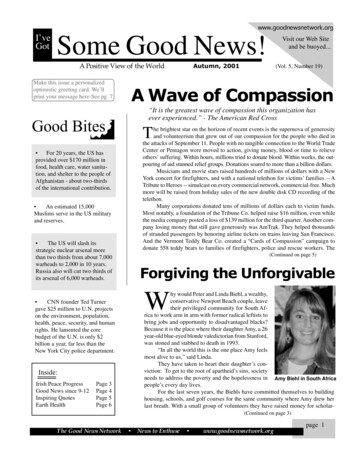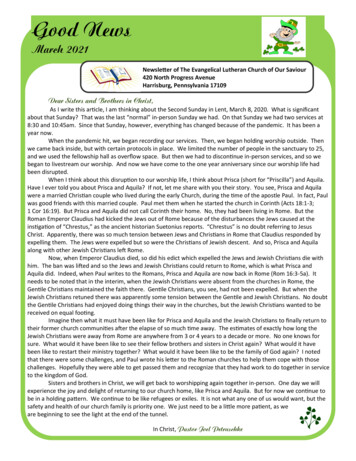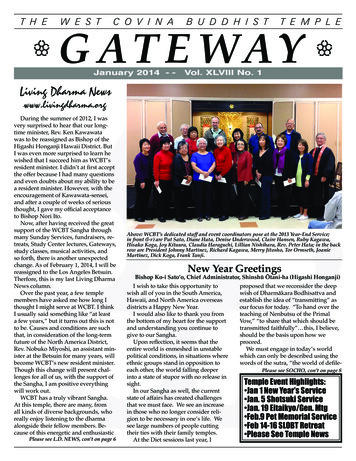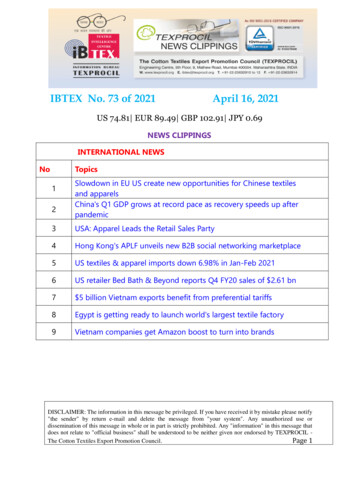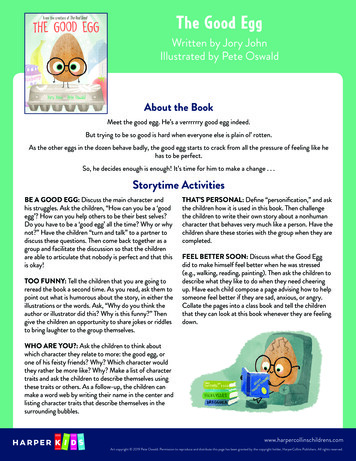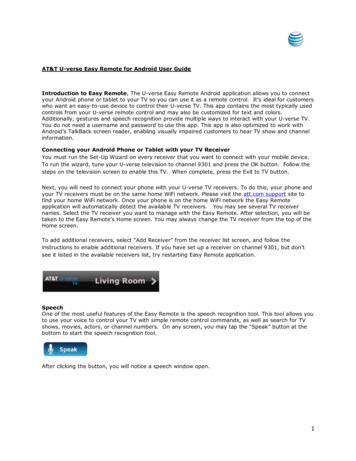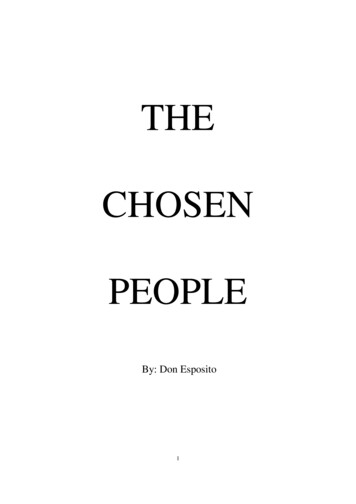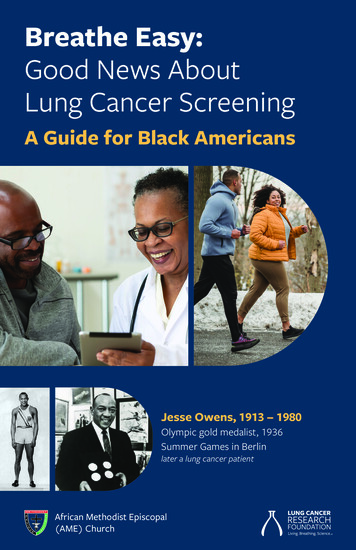
Transcription
Breathe Easy:Good News AboutLung Cancer ScreeningA Guide for Black AmericansJesse Owens, 1913 – 1980Olympic gold medalist, 1936Summer Games in Berlinlater a lung cancer patientAfrican Methodist Episcopal(AME) Church
Table of ContentsIntroduction. 5What is lung cancer?. 8Am I likely to get lung cancer?. 9How lung cancer differs in Black Americans. 11Symptoms of lung cancer. 12Why get screened. 13Screening guidelines. 17Treatments for lung cancer. 22Prevention: wellness strategies. 27Questions for your healthcare provider. 33Glossary. 36Resources. 37Photo CreditsPhotos of Jesse Owens are courtesy of the Jesse Owens Collectionat the Ohio State University Archive. The photo of Marlene OwensRankin and Stuart Rankin is courtesy of the Owens-Rankin Family.Most photos are stock images, acquired for illustrative purposes.The unidentified people in those photos are models.Breathe Easy: Good News About Lung Cancer Screening 3
IntroductionThere’s good news on the lung cancer front. Over the past40 years, deaths from lung cancer have been declining amongBlack Americans.More good news: when lung cancer is found and treated inits earliest stages, it can be cured much of the time. Today,more options than ever are available for treating advancedlung cancer.However, lung cancer is still a very serious problem. It’s theleading cause of all cancer-related deaths in the U.S.That’s not-so-good news for Black Americans. Compared withother groups, Black Americans get lung cancer more often,at an earlier age, and from smoking fewer packs per year. Putanother way, Black American smokers get lung cancer at least20% more often than other people who smoke.Scientists are doing something about that. Equally important,you can do something about it!Breathe Easy: Good News About Lung Cancer Screening 5
Cancer byby thethe numbers:NumbersLung cancerSome smokers and nonsmokers of all ethnicities1 in 15 menand1 in 17 womenwill develop lung cancer in their lifetime.For smokers, the risk is much higher.1 in 6 smokerseventually develops lung cancer.Cancer Deaths in the U.S.Lung cancer remains the leading cause of cancerrelated death in Black men and women, regardlessof their education, income, or occupation.This booklet explains:ɚ Risk factors for lung cancerɚ How lung cancer differs in Black Americansɚ The importance of early screeningɚ Next steps after screeningɚ Lifestyle choices to reduce the risk of getting lung cancer(2020 statistics, American Cancer 0Lung cancer causes about as many deathsas breast and pancreatic cancer combined.Breathe Easy: Good News About Lung Cancer Screening 7
Am I likely to get lung cancer?(risk factors)Anyone can get lung cancer. But certain things greatly increaseyour risk.Smoking is the biggest risk factor for getting lung cancer. That’strue whether you smoke cigarettes, cigars, or pipe tobacco.Their smoke contains at least 70 chemicals that cause cancer.The risk of lung cancer also increases with age.Other factors increase lung cancer risk.What is lung cancer?“Cancer” describes a group of cells that become abnormal andbehave differently than healthy cells do. Cancer cells multiplyfaster and live longer than normal cells. Cancer cells resist attackfrom the body’s immune system. Cancer may travel to andinvade other tissues.Environmental factorsHarmful chemicals, fumes, and dusts exist in certain work andhome environments:ɚ Radon (found in mines and some homes)ɚ Industrial pollutionɚ Diesel exhaust and bus fumesLung cells that become abnormal and grow out of control arecalled lung cancer. The main way lung cells become abnormalis from chemicals in tobacco that damage the cells’ DNA(genetic code).ɚ H eavy metals from mining (arsenic, beryllium, cadmium,chromium, nickel)Types of lung cancerɚ Coal mining and production of coal gas as fuelThe two main groups of lung cancer are non-small-cell lungcancer (NSCLC) and small-cell lung cancer (SCLC). Theydiffer by what the cells look like and how fast the cancer grows.Almost 90% of all lung cancers are NSCLC.ɚ S ilica (from sandblasting or foundry work, including thesteel industry)ɚ AsbestosNext to smoking, radon exposure is the second biggest riskfactor for lung cancer. All these environmental factors multiplythe risk of lung cancer when a person also smokes.Breathe Easy: Good News About Lung Cancer Screening 9
Geneticsɚ Family history of lung cancerɚ Certain genesOther health conditionsɚ Diabetesɚ Infection, especially human immunodeficiency virus (HIV)ɚ Chronic obstructive pulmonary disease (COPD)Diet (what you eat most often)ɚ A diet high in saturated fat and processed meat adds tolung cancer risk.But I don’t smoke!About 15% of people who get lung cancer don’t smoke.Nonsmokers can get lung cancer from secondhand smoke.A never-smoker who lives with a smoker is 25–35% more likelyto get lung cancer. Other risk factors, like genes and chemicalexposures, increase the risk of lung cancer in nonsmokers.Even people with no known risk factors can sometimes getlung cancer.ɚ Never-smoker: someone who has never smokedɚ Non-smoker: someone who smoked in the past butdoes not nowɚ Current smoker: someone currently using tobaccoHow lung cancer differs inBlack AmericansCompared with white Americans and other ethnicities,Black Americans:ɚ Have higher rates of lung cancerɚ Get lung cancer at a younger ageɚ Are diagnosed later, when the disease is advancedɚ Are more often still smoking when diagnosedɚ H ave the highest death rate from lung cancer—eventhough they smoke fewer cigarettes per dayWhite American male smokers consume 30–40% morecigarettes than their Black counterparts, but Black Americanmale smokers are 34% more likely to develop lung cancer.You can do something about that! Some risk factors such asfamily history are beyond your control, but you can do a lot toreduce your risk.Why does lung cancer hitBlack Americans so hard?The answer is complex. In addition to risk factors, there arepersonal factors:ɚ Distrust: I don’t have faith in the medical system.ɚ Denial: My lifestyle choices don’t affect lung cancer risk.ɚ Delay: I’ll get screened later.People also don’t realize that factors besides smoking increase risk.Breathe Easy: Good News About Lung Cancer Screening 11
Report new symptomsTell your doctor about any new symptom, such as tirednessor weakness that doesn’t go away or pneumonia that keepscoming back. Sharing this information helps your doctordiagnose you faster—whether for lung cancer or anything else.About 57% of lung cancers are diagnosed after the cancer hasalready invaded other parts of the body. Advanced lung canceris difficult to treat.On the other hand, 16% of lung cancers are found when thedisease is still confined to one part of the lung. Those cancersare highly treatable and often can be cured.Symptoms of lung cancerOften none! That’s why screening is so important.Common symptoms of lung cancer:Blood when you cough or spitRecurring respiratory infectionsEnduring cough that is new or differentAche/pain in shoulder, back, or chestTrouble breathingHoarseness or wheezingWhy get screened(and why people don’t)Just like any other kind of routine check-up, lung cancerscreening can find a health issue before it becomes a problem.The screening is a simple scan.Many people don’t get screened for lung cancer whenthey should.Screening guidelines now more fully reflect risks to BlackAmericans. Yet many people still don’t get screened. In fact,Black Americans have the lowest rate for getting screened,even when they have a referral from their doctor. Commonconcerns include Exhaustion, weakness, loss of appetiteSometimes a person may just feel like they have the flu, but itlasts longer than usual. People tend to ignore vague symptoms.Breathe Easy: Good News About Lung Cancer Screening 13
Concern /MisperceptionFactI need to stop smokingbefore I get screened.Not true. But any day is a goodday to stop smoking!I don’t have a cough,so I don’t need to bescreened.Lung cancer often doesn’t haveany symptoms until its latestages.Lung cancer isalways fatal.Screening checks for somethingbefore there’s a problem. Manylung cancers can be cured—especially when caught early.Radiation fromthe screening willhurt me.An extremely low amount ofradiation is used for medicalimaging.People will judge orblame me for beinga smoker.Smoking is not a judge ofcharacter. Most people willrespect you for making thehealthy choice to get screened.Insurance won’t payfor the screening.Insurance won’t payfor follow-up testing ifit needs to be done.Medicare and most otherinsurance plans pay for thescreening and follow-up tests.Concern /MisperceptionFactIf my screen isnegative, then it’sOK for me to keepsmoking.A normal CT scan simply meansyou probably don’t have lungcancer right now. Smoking is thesingle biggest risk factor for lungcancer, so periodic screeningsare very important.Smoking doesn’tincrease my chancesof getting sickvery much.One in 6 smokers eventuallygets lung cancer. Smokingalso increases the risk of heartdisease and other lung diseases.My lifestyle doesn’taffect my lungcancer risk.Yes, it may. Habits besidessmoking can affect your risk ina big way.I haven’t smoked foryears. I don’t need tobe screened.See the next chart to confirmwhether you should be screened.I want to quit smoking,but I can't afford thecost of a program.Talk with your doctor,pharmacist, a communitycounselor, or other provideryou trust regarding affordablequit options.I don't know whereto get help to quitsmoking.This booklet and its list ofResources at the end can help.Breathe Easy: Good News About Lung Cancer Screening 15
U.S. Preventive Services Taskforce2021 guidelinesLevel of Risk:HighRisk Factors:Age 50 to 8020 pack-years of smokingCurrently smoke or have quit within thelast 15 yearsAdditional Risk Factors: (any of the following):Secondhand smokeExposure to chemicals and air pollutionHealth conditions such as diabetes orchronic lung diseaseFirst-degree family relative (parents, theirchildren)with lung cancerShould I get screened?In general, people at high risk of lung cancer should be screened.The definition of “high risk” has changed recently. In 2020, theNational Comprehensive Cancer Network added a categorythat included risk factors often found in Black Americans. InMarch 2021, the U.S. Preventive Services Taskforce publisheda similar but more sweeping recommendation of who shouldbe screened. The net result: a broader age range and a lowernumber of pack-years of smoking are now included in the highrisk category.Get Screened?Notes:Yes*Pack-years: (# cigarettes per day / 20)x (# of years smoked)Screening frequency* Recommendations vary onscreening intervals (annually for several years, or lessfrequently over a longer time). Your doctor’s discretionand your medical history determines whether, or howoften, you should be screened.Breathe Easy: Good News About Lung Cancer Screening 17
In general, if you never smoked, haven’t smoked for at least15 years, or are older than 80 or younger than 50, you likelydon’t need to be screened unless your doctor suggests it. (Forexample, 10–15% of people with lung cancer have never smokedbut have other major risk factors.)The screening uses a piece of equipment called low-dosecomputed tomography, or LDCT. It takes a detailed 3D pictureof your lungs.Since LDCT started to be used for screening, ithas reduced cancer deaths by 20%. And it hasreduced deaths from other causes by almost 7%.You have everything to gain and nothing to lose bygetting screened!How do I get screened?ɚ T alk with your doctor or other healthcare provider (like anurse practitioner) to see if you should be screened.ɚ Get a prescription from your provider for the test.ɚ Y our provider will tell you which clinic or hospital has theright equipment for the screening.What is screening like?Simple!You don’t need to prepare for it. No one will poke you with aneedle. There’s nothing to drink beforehand. Metal affects theway LDCT takes pictures, so wear clothes that don’t containmetal (no metal buttons, studs, buckles, zippers). You canremove earrings, piercings, and other metal objects right beforethe test.Then you just lie on your back on a cushioned table. The tablemoves you into the machine, and the equipment takes picturesof your lungs. You don’t feel anything during the scan. It’sfinished in a few minutes. The machine makes some noise as ittakes pictures, but that’s it.Breathe Easy: Good News About Lung Cancer Screening 19
What if I get a positive result?Like mammograms, lung cancer screening sometimes finds spotsthat are not cancer. That happens around 13% of the time.Most of those findings are not a concern. Scar tissue or a pastinfection may look like a white spot or nodule on the scan. Thosefindings usually don’t look like cancer tumors.Lung cancer screening results86% negative13% findings thataren't cancerous1% findings thatwarrant furtherinvestigationOccasionally the scan may find a non-cancerous condition that iseasily treated. That’s another benefit of a lung scan.A doctor will read the scan and decide whether anything needs acloser look. She or he may recommend:ɚ A repeat scan in six months (to see if anything has changed)ɚ A different kind of scanɚ A biopsy (in rare cases—to analyze a small amount of lungcells microscopically)Getting one scan is a great start. But comparing scans fromyear to year lets your doctor look for changes. Only about18% of Black Americans return for a follow-up scan a year aftertheir baseline scan, even if it is negative. A negative scan simplymeans there's no sign of lung cancer right now. If your doctorrecommends an annual scan, for the sake of your health, pleasemake the scan a priority and keep the appointment!StagingIf a scan or biopsy shows abnormal cells, then more tests aredone to see what kinds of cells they are, where they comefrom, and whether they are cancerous or not. That helpsclinicians classify what they see. The method of classification,described with letters and numbers, is called staging. Stagingtells clinicians at a glance many things about a tumor. Stagingdescribes tumor characteristics: its size, whether it originated inthat spot, whether it’s grown into other tissues, whether lymphglands are involved, and so on. The lower the stage number, theless advanced the cancer is, and the better the outcome islikely to be.Breathe Easy: Good News About Lung Cancer Screening 21
SurgerySurgery is the best treatment for the earliest stage of lungcancer. Surgery removes the part of the lung that containscancer tissue. Your lungs contain sections called lobes. Surgeryremoves part or all of one lobe. The surgeon also checks nearbylymph nodes to make sure the cancer hasn’t spread.RadiationRadiation therapy is any type of high-energy beam that killscancer cells. Focused radiation is aimed at only the tumors.Radiation therapy can come from a machine or from a tinypellet implanted near the tumor.ChemotherapyTreatments for lung cancerMany treatments are available for lung cancer.A person’s general health, the extent of the cancer, and otherfactors determine which treatments are selected. Some mustbe given in a hospital or clinic because specialized equipmentand staff are needed for the treatment. Examples are radiationtherapy and intravenous (IV) treatments. Other treatmentssuch as pills (oral medicine) may be taken at home.Cancer cells grow and divide faster than normal cells.Chemotherapy damages the cells so they can’t grow.Chemotherapy can be given as a pill or an IV; it may be givenalone or with other drugs. Chemotherapy goes all through thebody, so it affects some healthy cells, too. Although it’s morecommonly given for later-stage lung cancer, it is also beingused with earlier-stage lung cancer, such as after surgery orradiation therapy.ImmunotherapyCancer can sneak undetected past your immune cells by“flipping a switch” that shuts them off. That keeps your cellsfrom noticing the cancer as “foreign” or “bad.” Immunotherapy(also called checkpoint inhibitors) resets that switch so yourbody knows to attack cancer cells.Breathe Easy: Good News About Lung Cancer Screening 23
Targeted therapyA targeted therapy is aimed specifically at certain genemutations or other features about cancer that help it survive.Many kinds of targeted therapies exist. Some of them blockcancer cells’ ability to grow, spread, or create new ways tonourish the tumor. Other targeted therapies block signals thatcan cause tumors to become resistant to treatments.Complementary medicineThis realm of medicine uses natural treatments in addition tothe ones already mentioned. They can help reduce side effectsfrom cancer or its treatments. But complementary medicine isnot meant to be a cure or a substitute for treatment prescribedby your doctor.Forms of complementary medicine that have been studied foreasing the effects of cancer or its treatments include:ɚ Yogaɚ Acupunctureɚ Tai Chiɚ Guided imageryɚ Meditationɚ Music therapyɚ Biofeedbackɚ WalkingComplementary medicine modalities can reduce inflammation,improve mood, and boost the immune system. Additionally,acupuncture can also decrease fatigue, nausea/vomiting, hotflashes, and shortness of breath.Complementary medicine may interfere with cancertreatments. It’s important to talk with everyone on thetreatment team to know the right time to use such treatments.Notes:Complementary medicine is not thesame as alternative medicine. Alternativemedicine greatly increases the risk oflung cancer death. Treatments, including"natural" ones, come with a risk of sideeffects or toxic reactions. Do not selfmedicate. Consult your care team beforetaking any medication.Breathe Easy: Good News About Lung Cancer Screening 25
Prevention: Wellness strategiesQuit smokingSmoking puts you at risk for all cancers—not just lung cancer.It also increases your risk for other diseases.It’s never too late to quit smoking—even if you’ve tried beforewithout success.When a person quits smoking before middle age,their lung cancer risk from smoking drops by asmuch as 90%.Palliative carePalliative care is treatment for symptoms related to side effectsfrom cancer or its treatment. Palliative care relieves nausea, pain,tiredness, anxiety, shortness of breath, and other symptoms. Ithelps any stage of illness.Note:This is not the same as hospice (end-of-life) care!Clinical trialsA clinical trial tests a new treatment to see if it’s safe andeffective. All new drugs are developed through the process ofclinical trials. Insurance companies may cover part or all the costof being in a clinical trial. Not nearly enough Black Americanstake part in clinical trials! Sometimes that is because peopledon’t know they exist. Transportation may be an issue. Whateverthe reason, if your doctor suggests a clinical trial, he or she canhelp you find the right one.Smoking is a form of addiction. It changes chemicals in yourbrain to make you crave nicotine. That makes it hard to quit.But you can do it. It’s your choice—for your life! The back ofthis booklet lists in-person programs, websites, apps, and morethat can help you quit. Choose the option that gives you thesupport you need through the quit process.What about e-cigarettes?The vapor in e-cigarettes does not contain the same chemicalsas tobacco smoke. But e-cigarettes do contain other chemicalsthat hurt the lungs. E-cigarettes might help some smokers whoare trying to quit, but the products are not considered safe foryouth, young adults, pregnant women, and people who havenever smoked.Breathe Easy: Good News About Lung Cancer Screening 27
ExercisePhysical activity can lower lung cancer risk by 20–50%.Walking 20–30 minutes per day, at least several days perweek, can reduce the risk of lung cancer and many otherhealth conditions.Have your annual checkupand if something is wrong, besure to follow up. Go to thedoctor on a regular basis, askthe questions, get the exams,and monitor yourself.Marlene Owens Rankindaughter of Jesse Owenspictured with her son, Stuart RankinBreathe Easy: Good News About Lung Cancer Screening 29
MindsetTake one day at a time. Focus on the present.Break down tasks into smaller pieces.(You don’t have to sort, wash, fold, and put laundryaway all in the same day.)Be kind to yourself if you can’t do everything you wantto do.If you are a spiritual person or a person of faith, leaninto that.Focus on what you can do to stay as healthy as possible.DietEating the right foods is very important, especially when youhave lung cancer. Healthy food choices help maintain yourweight and muscle mass.Living life to the fullest if youhave lung cancerLiving with lung cancer is a personal and group effort—one of personal choices and getting support from others.You alone can choose a mindset to adopt, and a healthylifestyle to follow.Lung cancer treatments can cause diarrhea or constipation,sores in your mouth, and other side effects that may affecteating. The disease can change your appetite and how well youdigest food. Tell your care team about all these issues; they arejust as important as your treatment regimen.It’s also important to drink enough liquids to stay hydrated.Coconut water, diluted juice, and filtered water are somegood choices.Links to more tips on healthy eating appear in the back ofthis booklet.Breathe Easy: Good News About Lung Cancer Screening 31
Questions for your healthcareproviderTalking with healthcare providers about lung cancer can bescary. But don’t be afraid to ask questions! Asking questions isan important part of being actively involved in your health. Youare a key member of your health team!SupportFind a doctor who will truly partner with you in your cancerjourney.It’s important to trust the person who recommends yourtreatments. If needed, get a second opinion. Insurance usuallycovers your visit for a second opinion.Ask if your doctor’s office has a nurse navigator. That personcan coordinate your care and help you make informed decisions.That can conserve your strength and reduce your stress.Write your thoughts in a journal to help you sort through yourfeelings.When providers talk about things you don’t know much about,it’s hard to remember everything they say. Make the mostof your appointment by coming prepared. Write questionsbeforehand. Take notes during the appointment. And don’t beafraid to say, “I don’t understand what means. Could youexplain that in simple terms?”The following pages give you space to write questions and notesduring your visit. We’ll say it again: write down your questions inadvance and take notes! (Or bring someone who will take notesfor you.) If you want to record the visit on your phone, ask yourprovider if it’s OK to do that.NotesFind a support group that understands your situation. Manyin-person and online groups are available. Also, a social workercan connect you with resources that best fit your needs.Be around people who can help you think about things otherthan cancer. For example, find a walking partner who is fine withwalking two blocks or ten with you.Breathe Easy: Good News About Lung Cancer Screening 33
NotesBreathe Easy: Good News About Lung Cancer Screening 35
GlossaryCheckpoint inhibitorA type of immunotherapy that blocks cancer cells’ ability toavoid being detectedChemotherapyTreatment that kills fast-growing cells in the body so they can’tgrow or multiplyComplementary medicineTreatments given in addition to conventional medicineImmunotherapyTreatment that stimulates the body’s immune response tofight cancerLow-dose computed tomography (LDCT)A scanning technology that combines special x-ray equipmentwith sophisticated computers to produce 3D images of theinside of the bodyNon-small-cell lung cancer (NSCLC)Cancer that starts in the outer region of the lung, in cells thatmake a liquid to coat and protect the lungs’ airway. A lesscommon form of NSCLC called squamous cell lung cancer canstart in the airways.Small-cell lung cancer (SCLC)A fast-growing cancer that starts in the bronchi (main breathingtubes of the chest) or the more central lung tissue. This type ofcancer grows faster than NSCLC.Targeted therapyCancer treatments that selectively identify and attack cancercells, with less harm to normal cellsResourcesCancer facts and figures for Black Americans(2019–2021)ɚ w fricanamericans-2019-2021.pdfInformation about lung cancer risks, causes,and preventionɚ w ntion.htmlLung cancer in African-American menɚ w ww.cdc.gov/cancer/lung/basic info/african-americaninfographic.htmRadiation therapy (radiotherapy)Cancer treatment that uses high doses of energy (radiation) tokill cancer cellsBreathe Easy: Good News About Lung Cancer Screening 37
Lung cancer screening guidelinesɚ N CCN: www.nccn.org/patients/guidelines/content/PDF/lung screening-patient.pdfɚ USPSTF: ation/lung-cancer-screeningHelp to quit smokingɚ w ww.quitassist.com/helpful-resources.htm?gclid EAIaIQobChMIi5b6uOA7wIVGx6tBh0nkQChEAAYAiAAEgJX2fD BwEɚ smokefree.govɚ betobaccofree.hhs.govWhere to get supportɚ w up/lung-cancer/ɚ www.lung.org/help-supportɚ w es.htmlɚ w owwe-can-help/Lung cancer treatmentsAll forms of standard treatmentsɚ www.lvng.com/treatments.htmlClinical trials for NSCLCɚ als/disease/non-small-cell-lung/treatmentClinical trials for SCLCɚ l supplementsɚ www.acam.org/search/all.asp?bst lung cancerHerbs relevant to lung cancerɚ eys Lung%20Cancer&letter Complementary medicineɚ ent/complementary-and-alternativeɚ www.nccih.nih.gov/health/cancer-in-depthHealthy eating and the Mediterranean dietɚ w 7801Living with lung cancerɚ w owwe-can-help/ɚ w ww.cdc.gov/cancer/lung/living/index.htm(This site also links to Livestrong, Lungevity, the NationalCancer Institute, American Lung Association, andmore sites.)Special Thanks to the Lung Cancer ResearchFoundation’s Patient Education Review CommitteeBreathe Easy: Good News About Lung Cancer Screening 39
people living with cancer, regardless of tumor type or stage of disease. This proto anyone in the United States, whether they’re currently on a Pfizer treatDisclaimerProgram PresenterThe Lung Cancer Research Foundation (LCRF); program funders BristolMyers Squibb, Novartis, Pfizer, Lilly, AstraZeneca, and Genentech; producersConrad & Associates LLC and Alan Weiss Productions, scriptwriter DeborahGobble, and guidebook author Lana Christian, have used reasonableefforts to include timely and accurate information in this guidebook andcompanion video. LCRF, the funders, the producers, and the writers make norepresentations or warranties, express or implied, regarding the accuracy orcompleteness of the information provided herein and specifically disclaim anyliability, express or implied, in connection therewith.NUTRITION & WELLNESSRESOURCES FOR OLDArticles about healthy living, exercise andEncouragement, educatioThe Lung CancerResearchFoundationdietary considerations as well as resourcesto helpolderadults navigaFoundation (LCRF)is the leadingTHISIS LIVING WITHCANCER anxiety, pain The Lung Cancer rofit organization focused on funding innovative, highand more.reward research with the potential to extend survival and A program for people living with cancer and those who love themimprove quality of life for people with lung cancer. LCRF'smission is to improve lung cancer outcomes by fundingresearch for the prevention, diagnosis, treatment, and curePATIENT ADVOCACYof lung cancer.COPING SKILLSTHIS IS LIVING WITH CANCER Interactive online skill-building activitieson topics such as goal planning, stressmanagement and communication.A program for people living with cancer and those who love themThis Is Living With Cancer is a free online resource developed by Pfizer Oncology for allpeople living with cancer, regardless of tumor type or stage of disease. This program is availableto anyone in the United States, whether they’re currently on a Pfizer treatment or not.NUTRITION & WELLNESSRESOURCES FOR OLDER ADULTSArticles about healthy living, exercise anddietary considerations as well as resou
smoking can affect your risk in a big way. I haven’t smoked for years. I don’t need to be screened. See the next chart to confirm whether you should be screened. I want to quit smoking, but I can't afford the cost of a program. Talk with your doctor, pharmacist, a community counselor, or other provider
